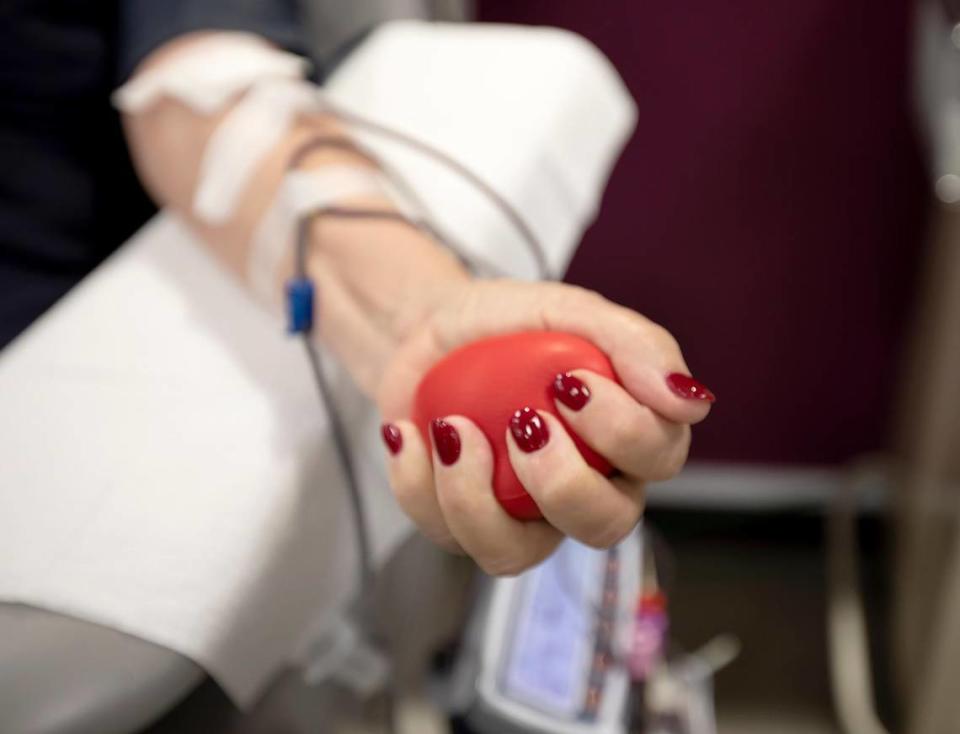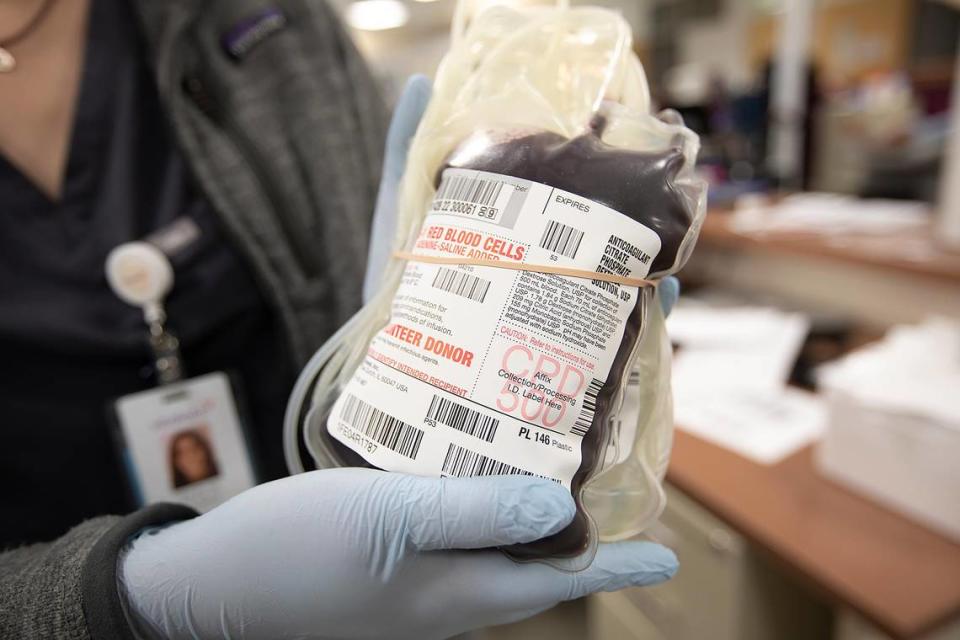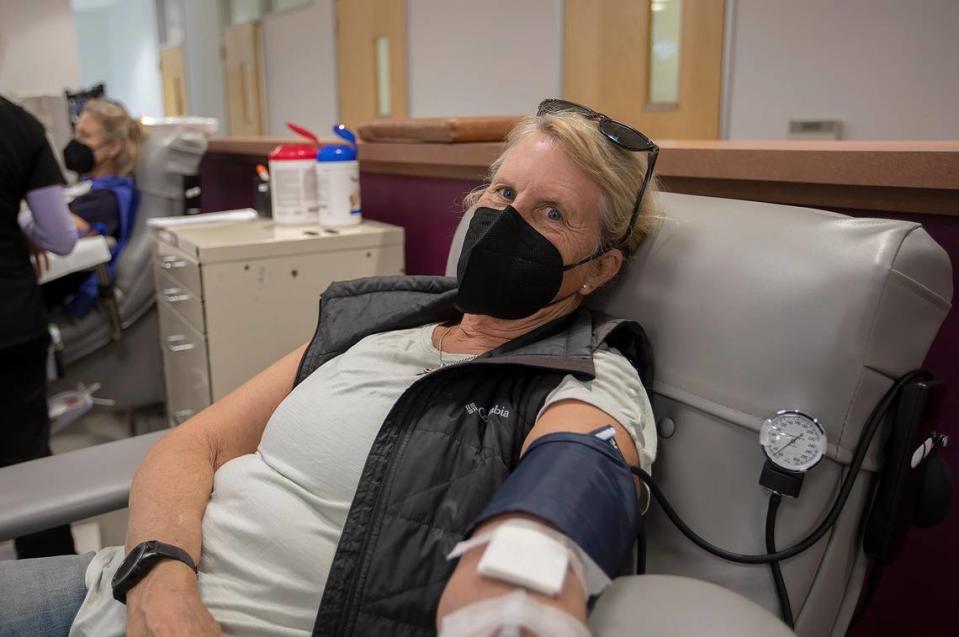Central Coast blood supplies are at a historic low due to COVID. Here’s how you can help
The nation is in the midst of a blood shortage due to the coronavirus pandemic, impacting the supply at San Luis Obispo County hospitals.
“Right now we are at a historic two-year low,” Vitalant donor recruitment representative Laura Kamada told The Tribune on Wednesday.
Vitalant, a nonprofit organization headquartered in Phoenix, Arizona that has an office in San Luis Obispo, supplies blood to 22 hospitals along the Central Coast, Kamada said.
The organization has seen a 10% decline in Central Coast donors in the past 12 months compared to the year before, she said. Kamada said there were 58,000 fewer individuals who gave blood in 2021 compared with 2020.
Vitalant has hosted blood drives at various locations throughout San Luis Obispo County to increase the blood supply to Central Coast hospitals and make it easier for people to donate.
Last week, Twin Cities Community Hospital in Templeton hosted a Vitalant blood drive.
They collected enough donor blood to save 126 lives at that event alone, Kamada said.
Although type O negative is the universal donor and type O positive the most common, all blood types have a particular use and purpose, she said.
“We’re asking all blood types to donate blood during these times,” she said.

Some of the factors behind donor blood shortage
One big reason for the drop in blood donors is the COVID-19 pandemic.
At the beginning of the pandemic, blood suppliers like Vitalant weren’t able to deploy “bloodmobiles.” Schools and college campuses — the locations for about half of Vitalant’s blood drives — were also closed, Kamada said.
That led to a sharp decline in blood supply, but it didn’t stop everyone from seeking out opportunities to donate.
Teresa Hicks started donating blood during the COVID-19 pandemic after hearing about the need from Vitalant.
“I think at the time they needed blood and I thought, well this is one thing that I can do,” Hicks said while donating at Vitalant in San Luis Obispo on Wednesday.
Another reason blood donations have declined is because the key demographic that tends to donate blood is aging.
“Our donor population really kind of came through World War II,” Tenet Health Central Coast lab director Daphne Martin told The Tribune. Martin manages the blood supply at Twin Cities and Sierra Vista hospitals.
Education is a core component to mobilizing a new generation of blood donors, Martin and Kamada said.
Vitalant has been doing outreach at local college and high school campuses to try to get the word out about the blood shortage.
“After 9/11 the donations were unbelievable across the nation,” Martin said. “I think when the country sees that they will usually step up. I think it’s just getting that information out.”
Many donors interviewed by The Tribune said they feel giving blood is a part of their civic duty.
Carol Timson Ball, of Templeton, donated at the Twin Cities Community Hospital blood drive last week.
Timson Ball isn’t a regular blood donor, but said she got a call from Vitalant asking her to come out.
“I feel sorry for the situation the country is in, and feel like I should do my part,” she said.
How blood shortage impacts SLO County hospitals
Every week, Vitalant will alert local hospitals about the blood inventory level throughout the region.
For the past two years, Tenet Health Central Coast hospitals have been moving in and out of Level Two, Martin said.
Level One blood inventory means hospitals are slightly below normal inventory levels, but overall everything is normal, she said. Level Two means hospitals have reduced blood levels in inventory.
“If one hospital has a greater need, (Vitalant) may come in and take some of our blood and use it throughout the county,” Martin said.
As of Wednesday, Vitalant had less than two days’ worth of blood available, when typically they have four days’ worth of supply, Kamada said.
Despite the shortage, hospital officials said the blood shortage hasn’t reached a level where patient care is impacted.
“It’s just more of an alert to us, so that we’re managing it as much as we can and letting physicians know if there are issues or any delays that might happen,” Martin said.

How hospitals changed donor blood protocols to conserve supply
Hospitals nationwide have adapted the way they use donated blood as the supply becomes less stable.
New advances in medicine show that less donor blood can be used upfront and lead to better patient outcomes, Martin said.
She said for many years the standard protocol was to give each patient two units of blood, but research shows it is safe to give one unit of blood to the patient and monitor to see if more is required.
Martin said that donor blood conservation can be used when treating chronically ill patients, but that doctors don’t typically focus on conservation when responding to trauma or emergency situations.
Another adaption in donor blood science involves matching blood types, she said.
The standard of care for many years was to use type O negative blood, the universal donor, for all emergency situations, Martin said.
But research indicates that type O positive blood can be used safely in emergency situations on men with type O negative blood types and for woman past child-bearing years, Martin said.
Type AB blood meanwhile is particularly good for plasma donation, Martin said.
What first-time blood donors can expect
Donating blood is a 20-to-30 minute time commitment.
Each donor should make sure they are well hydrated and eat a solid meal before donating, Kamada said.
After arriving at Vitalant in San Luis Obispo or a blood drive site, the donor will complete a basic health screening and medical questionnaire, Kamada said.
“Once you are done there, you get to go on the bed, and you’re donating blood and saving lives and eating snacks,” Kamada said.
There are a few ways to donate blood.
The most common type of blood donation is whole blood. Donors can also give power red blood cells, where a concentrated amount of red blood is collected and platelets and plasma is returned to the donor.
One pint of whole blood equates to three lives saved, while one pint of red blood is doubled to about six lives, she said.
Donors can also give platelet and plasma, which are particularly useful coming from A, B and AB blood types, according to the Vitalant website.
The machines that take the blood are different, but both options are valuable to health workers.
At the recent Twin Cities Hospital blood drive, 37 people donated blood. The majority opted for whole blood, while a few donated red blood, netting Vitalant 42 pints of blood from that event, Kamada said.
The majority of the donors attending the Twin Cities Hospital blood drive were health workers employed at Tenet Health Central Coast.
Hospital officials said this is fairly typical, because frontline health workers see blood is essential to the hospital’s ability to provide medical care.
For the Twin Cities Hospital blood drive, health workers learned about the blood drive right away and were able to sign up.
“We’re constantly in need of blood at the hospital,” nurse Jennifer McMillian said.
McMillian, who lives in Paso Robles and has worked at the hospital for the past 12 years, said she came into the hospital on her day off to donate blood because of the nationwide shortage.
Some people donate blood as part of their regular routine.
Jane Brennan, of San Luis Obispo, said she always donates blood because she feels its her duty as a member of the community.
“I’m part of the community and I think it’s important to give back,” she said.
Habitual donors can safely give blood every 56 days.

Upcoming blood drives on the Central Coast
There are numerous opportunities in the Central Coast between now and mid-February to donate, Kamada said.
If you wish to give blood, the first step is to confirm eligibility and make an appointment online at Vitalant’s website at www.vitalant.org.
There is a step by step explanation of the blood donation process on the Vitalant website at www.vitalant.org/blood-donation-process.
Below are some of the times and locations where Vitalant’s bloodmobile will be parked or a blood drive will be hosted.
Jan. 31: Mustang Village, San Luis Obispo; 2-6 p.m.
Feb. 1: Cal Poly, San Luis Obispo; 10 a.m.-3 p.m.
Feb. 5: Target; 2305 Theatre Drive, Paso Robles; 1-5 p.m.
Feb. 7, Feb. 8: Allan Hancock College, Santa Maria; 10 a.m.–2 p.m.
Feb. 8: North County Association of Realtors, 1101 Riverside Ave., Paso Robles; noon–4 p.m.
Feb. 9: Templeton Community Services District,420 Crocker St., Templeton; 2–6 p.m.
Feb. 10: Nipomo Community Services District, 148 Wilson St., Nipomo; 12:30–6 p.m.

